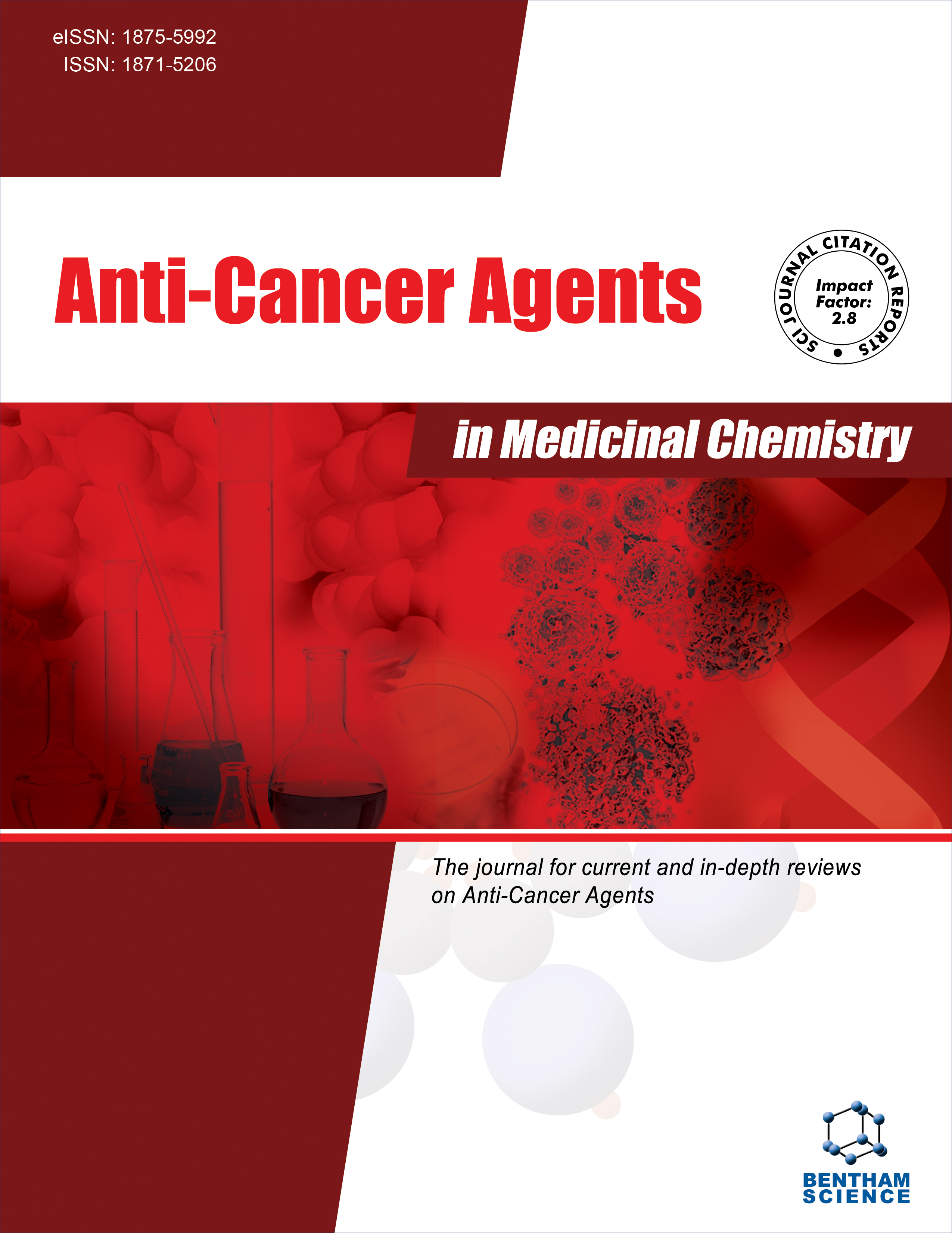- Home
- A-Z Publications
- Anti-Cancer Agents in Medicinal Chemistry (Formerly Current Medicinal Chemistry - Anti-Cancer Agents)
- Previous Issues
- Volume 24, Issue 19, 2024
Anti-Cancer Agents in Medicinal Chemistry (Formerly Current Medicinal Chemistry - Anti-Cancer Agents) - Volume 24, Issue 19, 2024
Volume 24, Issue 19, 2024
- Medicine, Oncology, Drug Design, Discovery and Therapy, Drug Design & Discovery, Chemistry, Medicinal Chemistry, Pharmacology
-
-
-
Relationships of Prodiginins Mechanisms and Molecular Structures to their Antiproliferative Effects
More LessAuthors: El Abbassi Ayoub, Zineb Azoubi, Zougagh Nadia, Mouslim Assia and Menggad MohammedThe Prodiginins (PGs) natural pigments are secondary metabolites produced by a broad spectrum of gram-negative and gram-positive bacteria, notably by species within the Serratia and Streptomyces genera. These compounds exhibit diverse and potent biological activities, including anticancer, immunosuppressive, antimicrobial, antimalarial, and antiviral effects. Structurally, PGs share a common tripyr Read More
-
-
-
-
Germacrone: A Multi-targeting Sesquiterpene with Promising Anti-cancer and Chronic Disease Applications
More LessAuthors: Navin Kumar Tailor, Ajmer Singh Grewal, Geeta Deswal and Ashwani Kumar DhingraBackground Germacrone, a naturally occurring active compound found in essential oils extracted from medicinal plants within the Zingiberaceae family, has garnered attention for its potential therapeutic applications. Extensive research has highlighted its multi-targeting capabilities, positioning it as a promising treatment for various chronic diseases, including cancer, cardiovascular conditions, and neurodegenerative Read More
-
-
-
Revolutionizing Cancer Treatment: Unleashing the Power of Combining Oncolytic Viruses with CAR-T Cells
More LessAuthors: Lin Zhang, ShuXian Guo, ShuYing Chang and Guan JiangOncolytic Viruses (OVs) have emerged as a promising treatment option for cancer thanks to their significant research potential and encouraging results. These viruses exert a profound impact on the tumor microenvironment, making them effective against various types of cancer. In contrast, the efficacy of Chimeric antigen receptor (CAR)-T cell therapy in treating solid tumors is relatively low. The combination of OVs and CAR- Read More
-
-
-
Pseudolaric Acid B Inhibits FLT4-induced Proliferation and Migration in Non-small Cell Lung Cancer
More LessAuthors: Panpan Lei, Jinna Liang, Xinyue Su, Jiapan Gao, Bingxi Ren, Xiaoyu Ma, Yuxiu Zhang and Weina MaObjectives Non-Small Cell Lung Cancer (NSCLC) has attracted much attention on account of the high incidence and mortality of cancers. Vascular Endothelial Growth Factor Receptor 3 (VEGFR3/FLT4), which is a highly expressed receptor in NSCLC, greatly regulates cancer proliferation and migration. Pseudolaric Acid B (PAB) is a diterpenoid acid with antitumor activity isolated from Pseudolarix kaempferi. This study aimed to Read More
-
-
-
A Novel Combinatorial Regimen Using Sorafenib and Uttroside B, A US FDA-designated ‘Orphan Drug’, for the Treatment of Hepatocellular Carcinoma
More LessIntroduction Sorafenib (Sor) is the first-line treatment option in clinics for treating advanced unresectable hepatocellular carcinoma (HCC). However, acquired chemoresistance and adverse side effects associated with Sor monotherapy limit its clinical benefits. We have previously reported the exceptional anti-HCC potential of uttroside B (Utt-B), a furostanol saponin isolated in our lab from Solanum nigrum Linn. lea Read More
-
-
-
Immunologic Mechanisms of BCc1 Nanomedicine Synthesized by Nanochelating Technology in Breast Tumor-bearing Mice: Immunomodulation and Tumor Suppression
More LessIntroduction The side effects of anti-cancer chemotherapy remain a concern for patients. So, designing alternative medications seems inevitable. In this research, the immunological mechanisms of BCc1 nanomedicine on tumor-bearing mice were investigated. Methods BALB/c mice underwent tumor transplantation and were assigned into four groups. Group 1 was orally administered with PBS buffer, Group 2 was orally administ Read More
-
Volumes & issues
-
Volume 25 (2025)
-
Volume 24 (2024)
-
Volume 23 (2023)
-
Volume 22 (2022)
-
Volume 21 (2021)
-
Volume 20 (2020)
-
Volume 19 (2019)
-
Volume 18 (2018)
-
Volume 17 (2017)
-
Volume 16 (2016)
-
Volume 15 (2015)
-
Volume 14 (2014)
-
Volume 13 (2013)
-
Volume 12 (2012)
-
Volume 11 (2011)
-
Volume 10 (2010)
-
Volume 9 (2009)
-
Volume 8 (2008)
-
Volume 7 (2007)
-
Volume 6 (2006)
Most Read This Month
Article
content/journals/acamc
Journal
10
5
false
en


